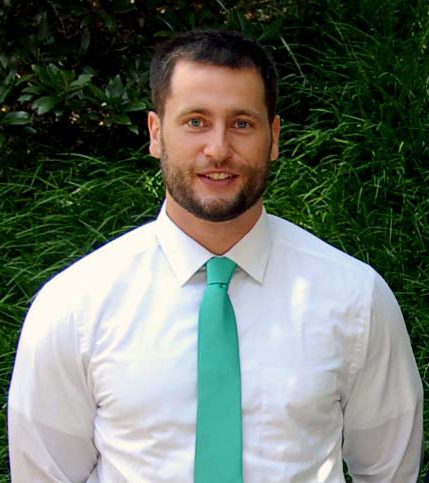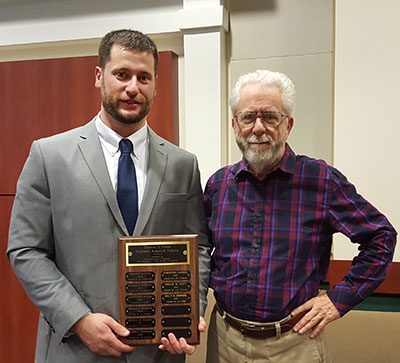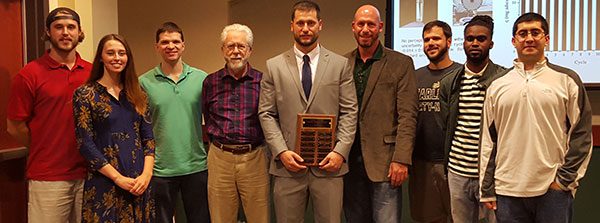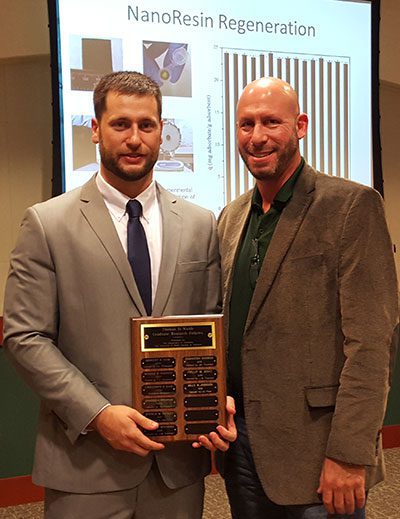2015 Thomas D. Walsh Graduate Research Fellowship Awarded to Billy Johnson

Billy Johnson earned his B.S. in Chemistry from the University of North Carolina at Charlotte in Fall 2011. He worked as a Chemistry Technician at Gastonia’s Water Treatment Plant before moving on to Special Metals Welding Products Company where he worked in quality assurance. Billy began his graduate studies at UNC-Charlotte Fall 2014. Upon completing his Master’s degree at UNC Charlotte, he plans to pursue a Ph.D. in a materials chemistry program focusing on environmental issues.
Billy currently works in the laboratory of Dr. Jordan Poler which focuses on fundamental studies of complex systems at the nanoscale with regard to applications of materials at the macroscale. Effectively using nanomaterials in different environments means that they must be assembled into useful structures. Specifically, single-walled carbon nanotubes (SWCNTs) are only dispersible in a limited number of solvents, and are essentially useless when dispersed into water where they immediately aggregate. Billy has developed hybrid nanoparticles that use SWCNTs as a scaffolding for a hydrophilic polymer, which allows the nanotubes to be dispersed into aqueous systems. The polymer is an anion-exchange resin (AER) that can be used to remove problematic contaminants from water, while utilizing the immense surface area of the nanotubes. These nanomaterials can be used to remove carcinogenic precursors from potential drinking water sources well below the EPA limits. Additionally, these functionalized nanotubes can be regenerated in a brine solution and reused.
Efficient and Effective Removal of Potentially Hazardous
Disinfection Byproducts from Drinking Water Using Novel Nanomaterials
Abstract:
Dissolved organic carbon (DOC) and natural organic matter (NOM) in natural waters is a source of a potential health hazard, and is difficult to remove. Modern water treatment methods rely on the use of chlorine as a disinfectant to remove bacteria. However, certain NOM (humic an fulvic acids) will reach with chlorine to form chlorinated disinfection byproducts (DBPs), which are known carcinogens. The EPA lists the maximum contaminant level for DBPs in the range of 0.01-1.0 mg/L. At such low concentrations, it is very difficult to remove NOM before the chlorination process. We have synthesized “nano-resins” by covalently attaching poly (vinylbenzyl trimethylammonium chloride in Single-Walled Carbon Nanotubes (SWCNTs were then characterized using Raman Spectroscopy, IR, and SEM. Raman data showed an increase in D:G band ration over pristine SWCNTs indicating covalent bonding to the nanotubes. Additionally. SEM images showed conformal coating of the polymer around the nanotubes.
Dissolved organic carbon can be extracted from water sources by adsorption to these polymer chains on the functionalized SWCNTs. These nano-resins are stable in water, and can be recycled and then reused through addition of NaCl. This is a sustainable solution to a difficult environmental problem. Work has also been completed to optimize the polymer chain length for enhanced DOC adsorption. We have characterized the use of these functionalized SWCNTs through the adsorption of a surrogate dye from water and from marine samples in local aquifers using UV-Vis and TOC analysis. Significant decreases in contaminant concentration were observed, even at very low concentrations. Adsorption studies show that our functionalized SECNTs are three times more efficient than currently available removal technologies and are capable of removing DOCs well below the limits set by the EPA; Langmuir adsorption studies confirm this, and show a significantly higher adsorbent saturation capability.


